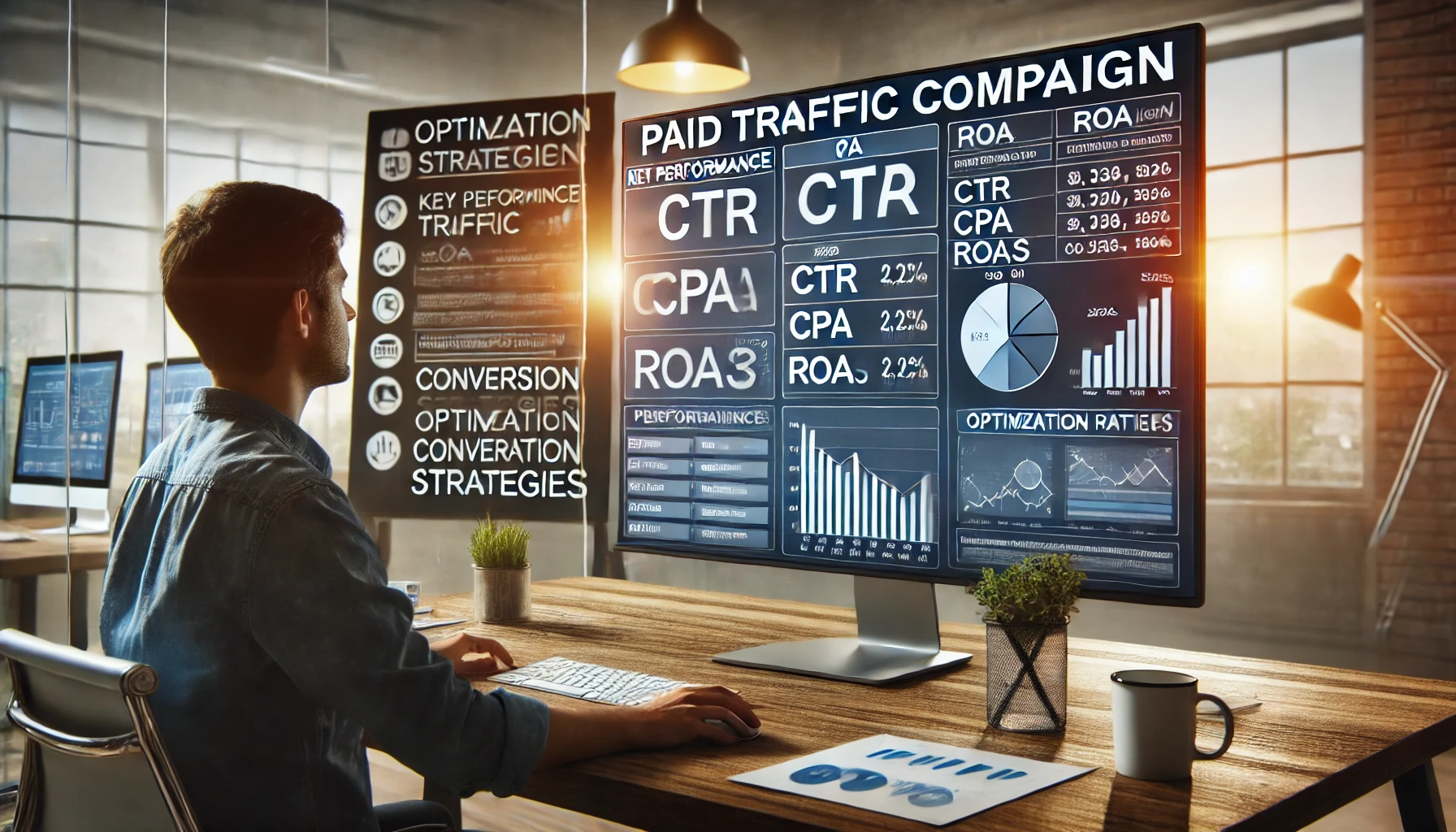📌 Introduction
Running paid traffic campaigns without analyzing data is like driving blindfolded—you won’t know what’s working, what’s failing, or where to optimize. Data analysis helps refine ad targeting, lower costs, and improve conversions by making informed, data-driven decisions.
In this guide, you’ll learn how to track, interpret, and use paid traffic data to optimize campaigns for better performance and higher ROI.
🎯 Why Data Analysis is Essential for Paid Ads?
✔ Identifies Winning & Losing Campaigns – Ensures budget is spent efficiently.
✔ Optimizes Ad Spend – Reduces wasted money on underperforming ads.
✔ Improves Audience Targeting – Helps find the most engaged users.
✔ Boosts Conversion Rates – Data-driven adjustments increase lead/sale generation.
🔎 1. Key Metrics to Track in Paid Traffic Campaigns
To optimize your ads, you need to track the right performance indicators.
✅ Important Paid Traffic Metrics & What They Mean:
| Metric | What It Measures | Why It’s Important? |
|---|---|---|
| Click-Through Rate (CTR) | % of users who click your ad. | Measures ad engagement & relevance. |
| Cost Per Click (CPC) | Cost for each ad click. | Helps control ad spend efficiency. |
| Conversion Rate (CVR) | % of visitors who complete a goal. | Shows how well traffic converts into leads/sales. |
| Cost Per Acquisition (CPA) | Cost to acquire a customer/lead. | Determines profitability. |
| Return on Ad Spend (ROAS) | Revenue generated per $1 spent. | Measures overall campaign success. |
Example: A business running Google Ads sees a CTR of 5% but a low conversion rate—this suggests the landing page needs improvement.
🛠 Recommended Tools:
- Google Ads Performance Reports – Tracks key ad metrics.
- Facebook Ads Manager – Monitors social ad engagement.
- Google Analytics 4 (GA4) – Analyzes user behavior after clicking ads.
📊 2. How to Use Data to Optimize Paid Traffic Campaigns
Once you’ve collected data, the next step is using it to improve ad performance.
✅ 1. Improve Ad Copy & Creatives Based on CTR
✔ If CTR is low (<2%), test new headlines, ad descriptions, or visuals.
✔ Compare image vs. video ads to see what drives better engagement.
Example: A fashion brand tests:
- Ad A: “Luxury Sneakers – 20% Off” (Static Image)
- Ad B: “Step Up Your Style – Limited Stock” (Video Ad)
🔹 Result: Ad B’s CTR is 40% higher, proving video ads perform better.
✅ 2. Reduce Cost Per Acquisition (CPA) by Refining Targeting
✔ If CPA is high, exclude low-quality traffic sources.
✔ Use Lookalike Audiences & Retargeting to target high-intent users.
Example: An online course business notices mobile users convert 30% less than desktop users, so they reduce mobile ad spend to lower CPA.
✅ 3. Increase ROAS by Adjusting Bidding Strategies
✔ If ROAS is low, switch to Target ROAS bidding on Google Ads.
✔ Test manual vs. automated bidding for cost efficiency.
Example: A SaaS company running Google Ads shifts from Maximize Clicks to Target ROAS bidding and sees a 20% improvement in profitability.
🛠 Recommended Tools:
- Google Optimize – Runs A/B tests for ad variations.
- Facebook Audience Insights – Refines ad targeting.
📢 3. How to Identify & Fix Underperforming Campaigns
Some campaigns drain budget without delivering results. Here’s how to identify and fix them:
✅ Signs of a Failing Campaign & How to Fix It:
| Issue | Possible Cause | Optimization Tip |
|---|---|---|
| Low CTR | Unappealing ad copy or poor audience targeting. | Test new headlines, images, and audience segments. |
| High CPC | Overcrowded bidding competition. | Adjust bidding strategy or explore cheaper keywords. |
| Low Conversion Rate | Weak landing page experience. | Improve page design, CTA, and load speed. |
| High CPA | Inefficient targeting. | Exclude low-quality audiences & retarget engaged users. |
Example: A real estate agency sees a high CPC on Google Ads for “Luxury Homes,” so they target long-tail keywords like “Luxury Homes in Miami” to lower costs.
🛠 Recommended Tools:
- Google Keyword Planner – Finds cheaper, high-intent keywords.
- Crazy Egg Heatmaps – Analyzes landing page engagement.
📈 4. Creating Custom Reports for Ongoing Campaign Optimization
To scale efficiently, create custom reports that track key trends.
✅ What to Include in a Performance Dashboard?
| Section | Metrics to Include |
|---|---|
| Traffic Overview | CTR, CPC, Total Clicks |
| Conversion Analysis | Conversion Rate, CPA, ROAS |
| Audience Insights | Engagement by age, gender, location |
| Creative Performance | Best vs. worst-performing ads |
🛠 Recommended Tools:
- Google Looker Studio (Data Studio) – Builds custom reports.
- Supermetrics – Automates cross-platform ad data collection.
🚀 Conclusion
Analyzing paid traffic data turns raw numbers into actionable insights. By monitoring CTR, CPC, CPA, and ROAS, refining audience targeting, and optimizing ad creatives, businesses can increase profitability while reducing wasted ad spend.
🔥 Key Takeaways
✔ Track CTR, CPC, CPA, ROAS, and Conversion Rates for performance insights.
✔ Optimize ad copy, targeting, and bidding based on data.
✔ Identify & fix underperforming campaigns early to prevent losses.
✔ Use custom reports & dashboards for ongoing campaign optimization.
By implementing these data-driven strategies, you’ll maximize your paid traffic campaign efficiency and boost overall ROI! 🎯
